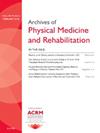一种确定慢性脑卒中患者上肢功能能力水平的新型聚类分析方案
IF 3.6
2区 医学
Q1 REHABILITATION
Archives of physical medicine and rehabilitation
Pub Date : 2025-05-01
DOI:10.1016/j.apmr.2025.03.026
引用次数: 0
摘要
卒中的结果或评估通常是在测量损伤或灵活性的竖井中进行的。最近,Woodbury等人开发了一种功能能力测量,旨在结合不同类型的评估(上肢Fugl-Meyer, ufm损伤测量和Wolf运动功能测试,wmft -功能能力测量),以提供对中风患者功能状态的全面了解。然而,功能能力如何在不同严重程度的中风范围内变化从未被确定,以建立针对性的上肢(UE)治疗。为了实现这一目标,我们的康复小组与统计建模专家合作,首次制定了一个分类方案,定义了区分慢性中风患者UE功能能力水平的截止分数。方法对efm +WMFT简写形式进行聚类分析,以确定具有相似功能容量水平的参与者组(范围:0-57)。我们通过剪影分析进一步评估聚类的一致性。结果:我们从三个资助的介入研究中收集了71名中风幸存者的基线数据。参与者的平均(标准差,SD)年龄为63.6 (SD 10.4), UEFM评分为30.1 (SD 17.5), WMFT功能能力评分为36.8 (SD 21.1)。我们的聚类分析结果支持三组UE功能容量分类方案:0-26(低),27-41(中等)和42-57(高)。平均剪影宽度为0.6,表明聚类具有合理的一致性。结论基于该分类器的重度特异性功能能力可为慢性脑卒中患者设计针对性的UE康复干预措施提供依据。本文章由计算机程序翻译,如有差异,请以英文原文为准。
A Novel Cluster Analysis Scheme for Determining Levels of Upper Extremity Functional Capacity in People with Chronic Stroke
Introduction
Outcomes or assessments in stroke are typically performed in silos of measuring impairment or dexterity. Recently, Woodbury et al. have developed a functional capacity measure that seeks to combine different types of assessments (Upper Extremity Fugl-Meyer, UEFM-impairment measure and Wolf Motor Function Test, WMFT-functional ability measure) to provide a comprehensive understanding of stroke patients' functional status. However, how functional capacity varies across different severity ranges in stroke has never been identified to build targeted upper extremity (UE) therapies. With this goal, our rehabilitation group, paired with statistical modeling experts, developed a classification scheme for the first time to define cut-off scores that differentiate levels of UE functional capacity in people with chronic stroke.
Methods
We performed cluster analysis of the UEFM+WMFT short form to identify groups of participants with similar levels of functional capacity (Range: 0-57). We further evaluated the consistency of the clusters through Silhouette analysis.
Results
We pooled seventy-one stroke survivors' baseline data from three funded interventional studies. Participants had a mean (standard deviation, SD) age of 63.6 (SD 10.4), UEFM Score of 30.1 (SD 17.5), and WMFT Functional Ability Score of 36.8 (SD 21.1). Results from our cluster analysis support a three-group classification scheme of UE functional capacity: 0-26 (Low), 27-41 (Moderate), and 42-57 (High). The average silhouette width was 0.6, indicating reasonable consistency of clusters.
Conclusion
Severity-specific functional capacity characterized using our classifier scheme can facilitate the design of targeted UE rehabilitation interventions for people with chronic stroke.
求助全文
通过发布文献求助,成功后即可免费获取论文全文。
去求助
来源期刊
CiteScore
6.20
自引率
4.70%
发文量
495
审稿时长
38 days
期刊介绍:
The Archives of Physical Medicine and Rehabilitation publishes original, peer-reviewed research and clinical reports on important trends and developments in physical medicine and rehabilitation and related fields. This international journal brings researchers and clinicians authoritative information on the therapeutic utilization of physical, behavioral and pharmaceutical agents in providing comprehensive care for individuals with chronic illness and disabilities.
Archives began publication in 1920, publishes monthly, and is the official journal of the American Congress of Rehabilitation Medicine. Its papers are cited more often than any other rehabilitation journal.

 求助内容:
求助内容: 应助结果提醒方式:
应助结果提醒方式:


